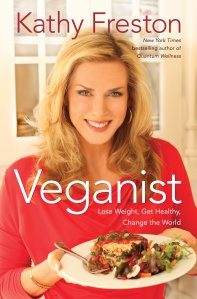Recently, I’ve become a vegetarian. The last actual meat I ate was a little more than five weeks ago when I had a turkey burger when my mother-in-law came over for our weekly Sunday dinner.
 Since then, I have been meat-free and mostly dairy free as well, although I am unable to resist mozzarella cheese on my homemade vegetarian pizza.
Since then, I have been meat-free and mostly dairy free as well, although I am unable to resist mozzarella cheese on my homemade vegetarian pizza.
There are lots of reasons for going vegetarian. Mine are for health purposes. I’ve been reading for years now that removing animal products from your diet can not only help prevent illness and give you more energy, but also can actually reverse chronic and potentially fatal diseases such as cancer, heart disease, diabetes and so on.
While I don’t have any life-threatening diseases (that I know of), I can tell you that since eliminating meat from my diet, I definitely have more energy throughout my day, feel healthier overall, and even seem to have a more positive outlook most of the time. While all of these could be psychosomatic, I really don’t think they are. I’m convinced they are related to my diet.
I’ve even started running again. Recent past efforts to return to running have all been cut short by injury or frustration, but now I’m running pain-free, look forward to my runs and am averaging about 15 to 20 miles/week.
I thought I would crave meat — and I probably did the first few days or so — but now the thought of eating meat sort of fills me with dread. Especially after reading about how animals are treated by food production. It’s truly horrible.
Another thing I worried about was that there wouldn’t be enough variety in a vegetarian diet to keep me interested in it. But that certainly hasn’t been the case. My wife and I have been eating a richer mix of foods than ever before. Where in the past we could get stuck in a rut — pasta/Mexican/pizza/grilled chicken/turkey burgers/repeat — in the past five weeks since I’ve started, we haven’t had the same meal twice.
If you would have told me a few years ago that I would be expounding on the benefits of vegetarianism or veganism, I would have called you crazy. In fact, like many people I looked upon vegetari ans with derision and a little suspicion. Yet here we are.
ans with derision and a little suspicion. Yet here we are.
I’m working toward veganism and have cut out 95% of dairy from my diet. Milk and eggs are essentially gone and — other than pizza — cheese is pretty much out of my life as well. read a book by wellness expert Kathy Freston in which she describes herself as a “vegan-ist”, or someone who is leaning towards veganism but hasn’t quite made the leap entirely. I think that pretty well sums up my mindset right now.
Here’s a recipe for Edamame and Orzo Salad that I modified (stole) from veghotpot, one of the vegetarian bloggers I admire the most. Edamame is a type of soybean that is similar to peas. You usually can find it in the frozen food section. If you can’t, frozen peas or even lima beans will work just as well.
Edamame and Orzo Salad
For the dressing:
Juice of 1 Lime
Few drops of Toasted Sesame Oil
1 TBS Bragg’s Liquid Aminos or Reduced Sodium Soy Sauce
1 Seranno Pepper, ribs and seeds removed, small dice
1 inch Ginger, peeled and minced
1 Garlic Clove, crushed
For the Salad
1 cup Edamame Beans
1 large Carrot, small dice
1 Zucchini
1 Yellow Squash
1 head Boston Bibb Lettuce
1/2 cup Orzo pasta, dry
To make the dressing, squeeze the lime juice into a bowl and add the sesame oil and liquid aminos. Add the Seranno pepper, garlic and ginger and add to the liquid in the bowl. Put to one side.
Steam the edamame beans for 3-4 minutes or microwave for a minute or two. Cook the pasta according to the packet instructions then run under cold water and allow to cool down with the beans.
Chop the lettuce into bite-size pieces. Cut the yellow squash and zucchini into thin strips. Toss together with the dressing and serve.






